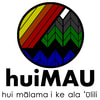Hoʻonaʻauao
naʻauao: nvt. learned, enlightened, intelligent, wise; learning, knowledge, wisdom. hoʻonaʻauao: to educate, instruct.
Integral to huiMAU's mission is the practice and process of hoʻonaʻauao, reciprocal education and consciousness raising. One of our long-term goals is to collectively restore community knowledge of place through ʻāina- and culture-based educational initiatives that focus particularly on reconnecting us to ancestral knowledge of place and enacting kuleana through place-specific practices of mālama ʻāina.
Keiki Papa:
|
KOʻA Camps:Foundational to our work is ʻāina (land) and aloha ʻāina—healthy, reciprocal relationships we develop with ʻāina by cultivating and caring for ʻāina, and sharing in its abundance. Continuing the pathways for our keiki to develop as aloha ʻāina in our community, huiMAU implements Koholālele ʻŌpio ʻĀina Camps (KOʻA Camps) for ages 13-17, including our Mālama ʻĀina Camp and Spring Break Camp. huiMAU’s KOʻA Camps are 4-day immersive overnight programs, which seek to mentor Hawaiʻi ʻōpio in Hawaiian culture-based values and practices of ʻohana, kuleana, and aloha ʻāina.
|
|
ʻUmi-a-Līloa Mural Project:
|
|
Moʻolelo no ʻUmi Blog:"He Moolelo no Umi" is one of the earliest known published versions of the story of ʻUmi-a-Līloa, the great chief of Hāmākua, Hawaiʻi. The version of this story that is republished and translated here was first published by Simeon Keliikaapuni in 1862, in a Hawaiian language newspaper, Ka Nupepa Kuokoa. Our kūpuna valued this moʻolelo and the lessons it imbued upon each generation who learned it. We, in the same spirit that inspired our kūpuna to retell this moʻolelo, represent it here, in both its original language and in english, so that our generation and the many generations to come may derive knowledge from the important lessons held within this moʻolelo. And so that we, kamaʻāina of Hāmākua, may find pride in the deep cultural heritage and history of our beloved homelands, the birthplace of this great chief, ʻUmi-a-Līloa.
|
|
